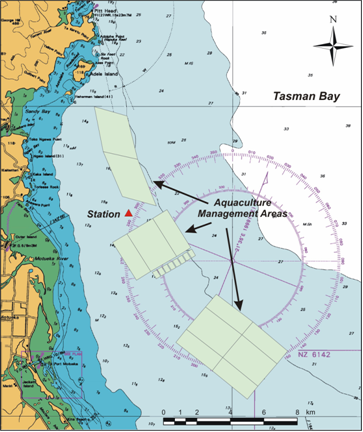Tasman Bay River Plume Ecosystem: Long term in situ data collection
Background
The Motueka River has been shown to affect the physical, chemical and biological makeup of Tasman Bay within a mobile but definable outwelling plume (ref. 1below). The plume region has been characterized through a series of synoptic surveys of water column and seabed properties/processes (2, 3, 4, 5). Such point-in-time investigations, however, do not adequately demonstrate either the evolving effects of short term variation in river flow/composition (e.g. flood events) or the longer term implications of changing weather patterns (e.g abnormal wet or dry periods) on coastal ecosystem processes. Long term data collection is therefore a prerequisite to filling in the gaps in our understanding of the effects of catchment activities on the river plume ecosystem.
ICM data buoy
A buoy-mounted, in situ data collection facility was therefore deployed in the plume-affected region of western Tasman Bay. The buoy station is located 6 km offshore from the Motueka River mouth and has subsequently been adopted by the Tasman District Council as a State of the Environment (SOE) monitoring site. The station was purposely established at a point 1 km from the outer boundary of an aquaculture management area proposed for long line culture of GreenshellTM mussels. Hourly midwater measurements of current speed & direction, conductivity, temperature, depth, chlorophyll a and turbidity are telemetered to Cawthron to automatically update data files and graphics. Additional surface and bottom water sensors are included to identify stratification characteristics, and variation in the quality of the feeding environment for scallops is assessed with near-bottom chlorophyll a and turbidity sensors.

Figure 1. Buoy-mounted, in situ data collection facility

Figure 2. Map of buoy location
Autumn phytoplankton bloom
Over the one-week period, 15-22 March 2007, we observed a 2ºC decrease in seawater temperature (18.5-16.5 ºC). This temperature decline seemed to signal the onset of a brief autumnal phytoplankton bloom with a series of chlorophyll a peaks of up to ~7 mg/m3. These chlorophyll a concentrations, although not calibrated using standard spectrophotometric methods, are high for the Bay (e.g. concentrations of ~5 mg/m3 would cause visible discolouration of the water) and they suggest ideal feeding conditions for shellfish. Note that turbidity (NTU) during this low rainfall period seems to track with chlorophyll a.
The onset of winter conditions
The period May through June 2007 shows the onset of winter conditions with seawater temperatures dipping to below 11ºC and reduced chlorophyll a concentrations of < 1 mg/m3. A short sharp rainfall event was captured 23-24 May that resulted in a slight decrease in midwater temperatures and salinities along with a distinct peak in turbidity. It took about 12 hours for the suspended sediment plume to reach the buoy.

Figure 3. Data from in-situ monitoring buoy covering period from March 16th through to April 20th, 2007

Figure 4. Data from in-situ monitoring buoy covering period from May 22nd through to June 30th, 2007

Figure 5. A closer view of the readings from the in-situ monitoring buoy after the flood event that occurred in the Motueka River on May 23rd-24th
References
- Tuckey B J, Gibbs M T, Knight B R, Gillespie P A. 2006. Tidal circulation in Tasman and Golden Bays: implications for river plume behaviour. New Zealand Journal of Marine & Freshwater Research.40: 305-324.
- Gillespie P. 2003. Benthic and planktonic microalgae in Tasman Bay: Biomass distribution and implications for shellfish growth. Report prepared for Stakeholders of the Motueka Integrated Catchment Management Programme. Cawthron Report No. 835. 25p + Appendices.
MacKenzie L. 2004. River inputs, re-mineralisation and the spatial and temporal distribution of inorganic nutrients in Tasman Bay, New Zealand. New Zealand Journal of Marine & Freshwater Research 38: 681-704. - MacKenzie L, Adamson J. 2004. Water column stratification and the spatial and temporal distribution of phytoplankton biomass in Tasman Bay, New Zealand: implications for aquaculture. New Zealand Journal of Marine & Freshwater Research 38: 705-728.
- Forrest B M, Gillespie P A, Cornelisen C D, Rogers K M. 2007. Multiple indicators reveal river plume influence on sediments and benthos in a New Zealand coastal embayment. New Zealand Journal of Marine & Freshwater Research. 41: 13-24.
Contacts: Paul Gillespie or Paul Barter